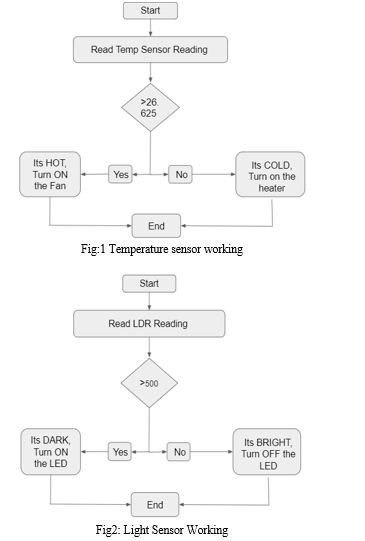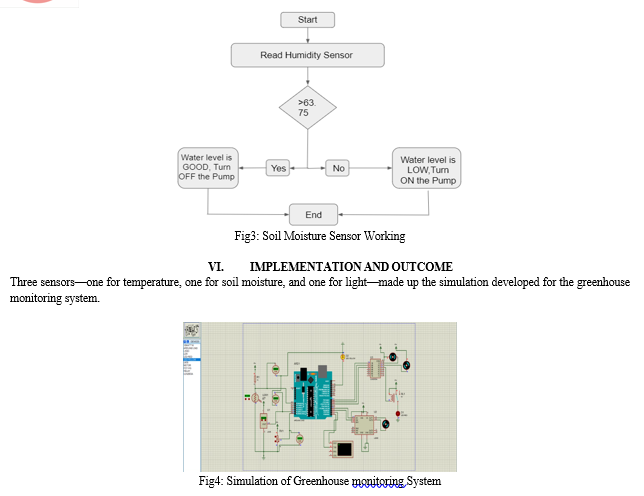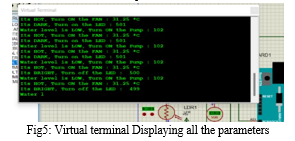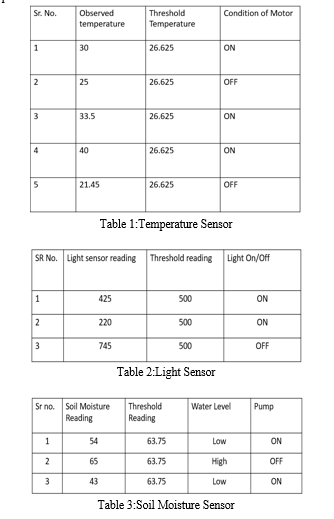Ijraset Journal For Research in Applied Science and Engineering Technology
- Home / Ijraset
- On This Page
- Abstract
- Introduction
- Conclusion
- References
- Copyright
Automated Greenhouse Monitoring System
Authors: Prof. Shital Raut, Siddhida Hulwane, Harsh Iramani, Chinmay Jadhav, Jaysinh Jagdale
DOI Link: https://doi.org/10.22214/ijraset.2022.47940
Certificate: View Certificate
Abstract
The greenhouse, a crucial component of agricultural infrastructure, has been instrumental in the advancement of modern agriculture by providing plants with a healthy environment. Manually monitoring and managing the many settings is challenging. Maintaining production quality is another important responsibility. This study proposes an automated greenhouse monitoring and control system that uses a variety of sensors, including temperature, soil moisture, light, photoionization, and soil moisture sensors, to collect potential environmental parameters of the greenhouse and integrate Arduino Uno R3 (to store and process data). The goal is to create a system that would concentrate exclusively on the cultivation of papaya, cucumber, tomato, and brinjal. The outcomes will be a fully comprehensive
Introduction
I. INTRODUCTION
[1] Since the dawn of civilization, farming has been one of man's main vocations, and even now, manual labour is still necessary in many situations. To grow the correct crops at the right time in the right soil, traditional farmers must routinely visit their fields to measure the many environmental factors, including temperature, humidity, light intensity, and soil moisture. Even though this conventional farming method has been around for a while, it is chaotic and frequently results in low productivity rates since the farmer is unable to correctly assess all the variables. [2] There are several issues relating to people's food supplies brought on by climate change. The country's horticulture and agriculture industries depend heavily on greenhouses because they
A structure where plants are grown is called a greenhouse. The cultivation of fruits, vegetables, and flowers is frequently done in greenhouses. Sunlight, soil moisture content, temperature, and other fundamental elements all have an impact on plant growth. Inside a greenhouse, it is challenging to manually manipulate these physical parameters. Automating this monitoring system is one option.[3] An intelligent microcontroller-based greenhouse system is another method of controlling these parameters. As it is expensive and some physical elements are interconnected, it is impossible to automatically control every aspect that influences plant growth.[4] With a redesigned architecture, IOT is now used for this monitoring.[5] IOT-based greenhouse monitoring models have also been used recently. A green revolution in agriculture may result from the implementation of "AUTOMATED GREENHOUSE MONITORING SYSTEM". The introduction of this method will contribute to an increase in controlled-environment farming. An essential component of the horticulture and agriculture industries is the greenhouse environment, which is utilized to grow plants under regulated climatic conditions for effective production. The use of WSN for greenhouse monitoring as indicated in [5] and [6] may also be taken into consideration. The factors of soil moisture, temperature, and light are necessary for plant growth. These parameters must be produced by the greenhouse's environment. [7] The majority of typical greenhouse plants need a temperature range of between 18 to 24 C. (64 F-75 F). We find these temperatures in most greenhouses across the world since they are thought to be ideal for the majority of common crops. Growers rarely deviate from this temperature range because doing so would typically result in delayed or stopped growth and subpar produce quality. In greenhouses and other indoor growing environments, humidity control is essential. Any facility will experience condensation if the humidity is not controlled. The growth of diseases that can quickly wipe out vast quantities of vegetables, cannabis, or any other crop is caused by the availability of this free water.
Through our initiative, we are putting forth a system that will concentrate on creating a greenhouse climate for a certain type of plant.
II. OBJECTIVE
To gauge and keep an eye on the many greenhouse factors, such as temperature, soil moisture, light, and dangerous gasses, and to make adjustments as necessary to meet the needs of the crop in order to maximize and accelerate growth Yield.
- To maintain greenhouse temperature at roughly 26.625 *C (which is average optimal temperature for crops chosen)
- To maintain a greenhouse's ideal soil moisture percentage at 63.75 (which is average optimal humidity for crops chosen) keep the researched vegetable species' estimated light compensation level of 6 J cm2 per day.
- To issue a warning regarding the following unsafe amounts of harmful gasses:More than 700–800 ppm of CO2 0.05 ppm of ethylene Should be less than 0.2 ppm of sulfur dioxide in the air
III. LITERATURE SURVEY
[1] Greenhouse Using an Arduino system, a monitoring and control system, 2019 This study aims to support small-scale farmers' convenience and ease of plant growth. Small farmers will be able to grow healthy crops all year long with little oversight according to the suggested method. Monitor changes in temperature, humidity, and light intensity using this system.[2] The creation of an automated system for managing a greenhouse.
The automation system demonstrates how it might reduce yearly water usage. Automation must also take into account the needs of the plants and not merely focus on lowering water usage. Only the benefits of the automated system in terms of lowering consumables, like water, have been mentioned in this study.[3] Microcontroller-Based Intelligent System for Monitoring and Controlling the Environment in Greenhouses The monitoring and control system for greenhouse farming is described in this research as being straightforward and intelligent. With a sensor array and autonomous operation, the system tracks crucial greenhouse parameters in real-time.[4]
Design and prototyping of an Internet of Things system for greenhouse monitoring. This study has been successful in creating a working prototype of an internet of things (IoT)-based system for tracking greenhouse environmental conditions.[5] Automated greenhouse monitoring system powered by IoT. In a closed greenhouse setting, the ideal circumstances required for the growth of the SPINACH crop are automatically maintained.[6] The International Conference on Control, Automation, and Robotics Design of Greenhouse Environment Monitoring System Based on Wireless Sensor Network. This study offers a design for a greenhouse environment monitoring system that uses temperature, humidity, and light intensity sensors to combine detection, communication, alarm, display, and other tasks into one.[7] In 2019, the International Conference on Computing, Control, Networking, Electronics, and Embedded Systems Engineering presented a paper titled "Greenhouse Monitoring and Control System Based on Wireless Sensor Network. “In a greenhouse, wireless sensor nodes equipped with temperature and humidity sensors were used to create a WSN.[8] Analysis and Prediction of Crop Greenhouse Parameters Journal of Computer Applications International, IEEE.The parameters of the crops' greenhouses are examined using a variety of sensors. Cucumber, tomatoes, brinjals, papaya, and other crops were chosen for analysis. The necessary ideal range of greenhouse characteristics for each of these crops is also taken into account simultaneously.
IV. COMPONENTS USED
- Temperature Sensor: The system automatically activates the fan when the temperature exceeds a predetermined or critical level. On the other hand, the fan automatically shuts off if the detected temperature falls within the usual range or below the set level. a temperature sensor, in which the IC LM35 serves as the main component, has been employed.
- The LM35 gadget operates between 55 and 150 degrees Celsius.: he operational voltage ranges from 4V to 30V, with the ideal temperature ranges being 18o-24oC (64o-75oF) and 30°F to 54°F (1°C to 12°C).
- Light Sensor: In a greenhouse system, light intensity is another key factor. Crop growth requires the right amount of light intensity. Changing light levels could have a negative impact on plant growth and reduce production. The light sensor module has an LDR that measures light intensity. Low light intensity is addressed by the use of artificial lights.
- Humidity Sensor: For the production of any crop, relative humidity is a crucial climate parameter. The greenhouse system that has been proposed has been implemented using humidity sensor units, or HSU-07 Series. It operates between 0 and 7 volts.-20 to +60 °C is the operating temperature range. Operating humidity is 20 to 90% relative humidity, specifically 80%. R1atio of Humidity
- Soil Moisture Sensor: The soil's moisture content was ascertained using a soil moisture sensor. The amount of moisture in the soil can be determined by inserting two soil moisture sensor probes into the ground.
- Using a reference to a photoionization sensor, an on-board computer measures the concentration of ethylene.
- Arduino Uno R3 is used to process and store the data gathered by the various sensors stated above: In this project, a microcontroller board based on the ATmega328 called Arduino Uno R3 is used. It has 6 analogue inputs, a 16 MHz crystal oscillator, 14 digital input/output pins (six of which can be used as PWM outputs), a USB port, a power jack, an ICSP header, and a reset button. All of these modules are required to support the microcontroller, which can then connect to the computer through a USB cable or be powered initially by a battery or an AC-to-DC adapter.
- LCD (Liquid Crystal Display) Module: Used to display the parameters to the user. In this system, we have used a 20×4 LCD and its operating voltage is 5V.
V. PROPOSED METHODOLOGY
By employing a photoionization sensor to measure the amount of poisonous gasses like ethylene, carbon dioxide, and methane, among others, we will be able to address the problem of crop damage caused by these gasses.
Since temperature is the most important factor to consider while monitoring a greenhouse, this project will help us control the temperature. The technology turns on the fan automatically when the temperature exceeds a preset or critical threshold. On the other hand, the fan automatically shuts off if the detected temperature falls within the usual range or below the set level.
Crop yield is influenced by humidity levels, which can be measured and tracked in the system. For healthy plant growth, soil moisture is crucial. Using a soil moisture sensor, it has been determined
The amount of light present is crucial in a greenhouse setup. Crop growth requires the right amount of light intensity. Variations in light intensity may negatively impact plant development and reduce output. To fix the low light intensity issue within the greenhouse, artificial lights are utilized.
Artificial lights automatically come on when a defined level of light intensity is compared to a lower level. The artificial lights automatically turn off when the ambient light intensity is within a typical range.
We can assess the level of harmful chemicals like benzene, carbon dioxide, methane, and ethylene in the air to prevent damage to crops. We will address the issue of agricultural damage brought on by harmful gasses with our project.


The circuit includes the following parts: an LDR, an LM35, a soil moisture sensor, three DC motors, an Arduino Uno, two yellow LEDs, one red LED, and three motors. We use an LM35 for temperature functionality, with one end grounded and the other linked to the Arduino UNO's A4 pin. Its output is derived from the Arduino UNO's pins 5 and 7. These pins are later connected to a transistor array motor and an LED heater.
An LDR with one end linked to the ground and the other to the Arduino UNO's A0 pin is used to control the light. Its output is obtained from Arduino UNO pin number 13, which is connected to the yellow LED.
We have a potentiometer that serves as a soil moisture sensor for functionality related to soil moisture level. One end of it is attached to the ground, and the other end is connected to Arduino UNO pin number A5. A DC voltmeter is wired to it. Its output is obtained from pin number 6, which is connected to a motor via pin number 15 of the transistor array

As we can see, the messages related to the current situation are printed on the virtual terminal. The fans are activated because the temperature is over the ideal level for the situation. The LED is turned on because the greenhouse doesn't have enough light intensity. The water in the pump is turned on because the water level is low.

VII. FUTURE SCOPE
By using WSN, the system may be turned wireless.To find too many pesticides, another sensor is employed, like enzyme biosensors. The automatic greenhouse monitoring system's equipment is powered by unconventional energy sources like solar cells and wind turbines. It will start a revolution and has a promising future in the sector of agriculture.
Conclusion
In this study, a streamlined, clever monitoring and controlling system for greenhouse farming is described. The greenhouse\'s gas level as well as changes in temperature, humidity, and light intensity could all be tracked by the greenhouse\'s monitoring and control system. Based on the many changes in the environment, the various sensors were able to adjust. This study aims to support small-scale farmers\' convenience and ease of plant growth. Small farmers will be able to grow healthy crops all year long with little oversight according to the suggested method.
References
[1] Yahaya, Aisha, Yusuf Aleshinloye Abass, and Steve A. Adeshina. \"Greenhouse Monitoring and Control System with an Arduino System.\" In 2019 15th International Conference on Electronics, Computer and Computation (ICECCO), pp. 1-6. IEEE, 2019 [2] Cosman, Sorin Iulian, Cristina Adina Bilatiu, and Claudia Stelu?a Mar?i?. \"Development of an automated system to monitor and control a greenhouse.\" In 2019 15th International Conference on Engineering of Modern Electric Systems (EMES), pp. 1-4. IEEE, 2019. [3] Mahfuz, Nagib, Rounak Jahan, Md Mominul Islam, Mehen Nigar, and Shawan Karmokar. \"Microcontroller Based Intelligent Greenhouse Environment Monitoring and Controlling System.\" In 2020 IEEE International Women in Engineering (WIE) Conference on Electrical and Computer Engineering (WIECON-ECE), pp. 418-421. IEEE, 2020. [4] Widyawati, Dewi Kania, Agus Ambarwari, and Anung Wahyudi. \"Design and prototype development of internet of things for greenhouse monitoring system.\" In 2020 3rd International Seminar on Research of Information Technology and Intelligent Systems (ISRITI), pp. 389-393. IEEE, 2020. [5] Danita, M., Blessy Mathew, Nithila Shereen, Namrata Sharon, and J. John Paul. \"IoT based automated greenhouse monitoring system.\" In 2018 Second International Conference on Intelligent Computing and Control Systems (ICICCS), pp. 1933-1937. IEEE, 2018. [6] Liu, Lijun, and Yang Zhang. \"Design of greenhouse environment monitoring system based on WirelessSensor Network.\" In 2017 3rd International Conference on Control, Automation and Robotics (ICCAR), pp. 463-466. IEEE, 2017. [7] Mekki, Marwa, Osman Abdallah, Magdi BM Amin, Moez Eltayeb, Tafaoul Abdalfatah, and Amin Babiker. \"Greenhouse monitoring and control system based on wireless sensor network.\" In 2015 international conference on computing, control, networking, electronics and embedded systems engineering (ICCNEEE), pp. 384-387. IEEE, 2015. [8] Asolkar, P. S., and U. S. Bhadade. \"Analyzing and predicting the green house parameters of crops.\"International Journal of Computer Applications 95, no. 15 (2014).
Copyright
Copyright © 2022 Prof. Shital Raut, Siddhida Hulwane, Harsh Iramani, Chinmay Jadhav, Jaysinh Jagdale. This is an open access article distributed under the Creative Commons Attribution License, which permits unrestricted use, distribution, and reproduction in any medium, provided the original work is properly cited.

Download Paper
Paper Id : IJRASET47940
Publish Date : 2022-12-07
ISSN : 2321-9653
Publisher Name : IJRASET
DOI Link : Click Here
 Submit Paper Online
Submit Paper Online

